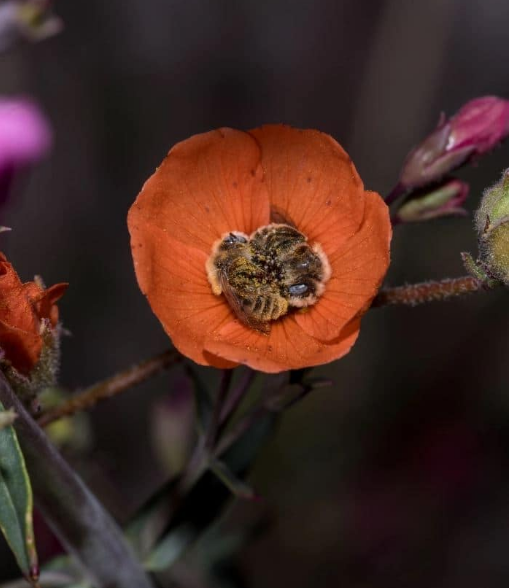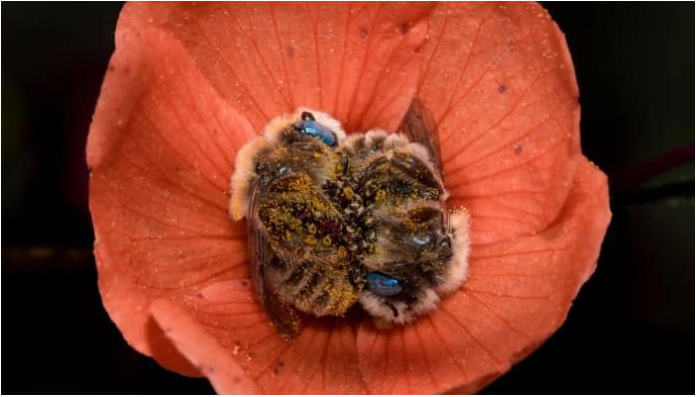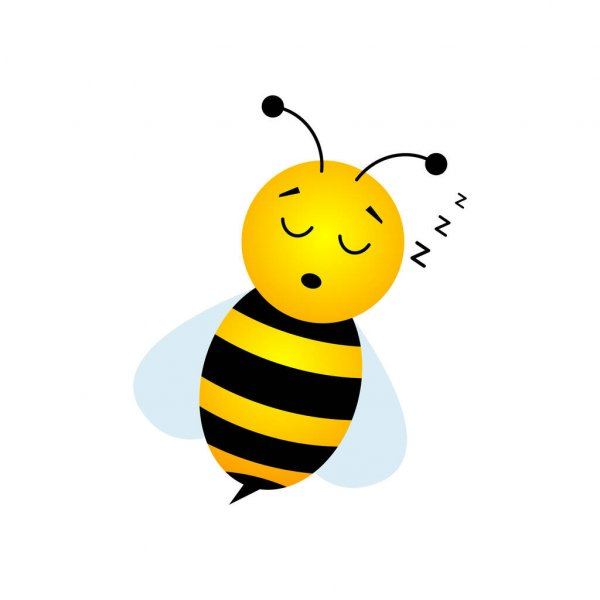Sabias ¿como duermen las abejas?
**Did you know how bees sleep?
Hoy me encontré en Facebook, esta preciosa foto de dos abejas impregnadas de polen en lo que podría ser una amapola, donde decía. " dos abejas duermen abrazadas en una flor". Esta fotografía me dio que pensar e investigué algo al respecto. Hoy quiero hacer mi primera publicación en esta comunidad hermosa con este tema, ya que somos una colmena 🐝🐝🐝 Reino Animalia
Today I came across on Facebook, this beautiful photo of two bees impregnated with pollen on what could be a poppy, where it said. "two bees sleep hugging each other on a flower". This picture gave me food for thought and I did some research on it. Today I want to make my first post in this beautiful community with this topic since we are a beehive 🐝🐝🐝 Animalia Kingdom.
El científico que descubrió por primera vez que las abejas duermen fue Walter Kaiser. Observó que las abejas descansan inclinando la cabeza hacia el suelo, bajando sus antenas y apoyando sus alas en el cuerpo.
Las abejas no tienen párpados, así que no puedes buscar abejas con los ojos cerrados, trabajan día y noche y se turnan para dormir dentro de la colmena. Sus patrones de sueño cambian a medida que crecen.
Las abejas más jóvenes duermen menos, pero las más viejas descansan entre 30 minutos y una hora y media cada noche, y toman pequeñas siestas de unos 15 a 30 segundos a la vez.
Pero estas dos abejas se abrazaron juntas en la flor e hicieron la composición perfecta.
The scientist who first discovered that bees sleep was Walter Kaiser. He observed that bees rest by tilting their heads to the ground, lowering their antennae and resting their wings on their bodies.
Bees don't have eyelids, so you can't look for bees with their eyes closed, they work day and night and take turns sleeping inside the hive. Their sleep patterns change as they grow older.
Younger bees sleep less, but older bees rest for 30 minutes to an hour and a half each night, and take short naps of about 15 to 30 seconds at a time.
But these two bees cuddled together on the flower and made the perfect composition.
El fotógrafo Joe Neely captó a dos abejas acurrucadas en el centro de una flor. La imagen por sí misma revela un lado de los insectos que raramente vemos, regordetas y llenas de polen, las abejitas descansan en flores, Las abejas melíferas duermen por turnos en su colmena, entre 30 minutos y una hora y media cada noche.” comunicó el fotógrafo.
Photographer Joe Neely captured two bees huddled in the center of a flower. The image itself reveals a side of the insects we rarely see, plump and full of pollen, the little bees rest in flowers. Honeybees take turns sleeping in their hive for 30 minutes to an hour and a half each night," the photographer said.
¿Cómo saber si una abeja está durmiendo?
Al no tener párpados, para identificar si una abeja está durmiendo hay que mirar con atención sus antenas, ya que dejan de moverlas al estar dormidas, o ver si están acurrucadas hacia un costado.
¿Por qué duermen las abejas?
Las abejas cuando duermen reducen su metabolismo, ahorrando energía puesto que necesitarían ingerir alimento en cantidades muy superiores, alimento que de noche no pueden recolectar.
Las investigaciones han demostrado que mientras duermen, la temperatura corporal de las abejas disminuye y se necesita una luz más brillante para despertarlas que la intensidad de la luz a la que normalmente responderían.
Why do bees sleep?
When bees sleep, they reduce their metabolism, saving energy since they would need to ingest much more food, which they cannot collect at night.
Research has shown that while they sleep, bees' body temperature decreases and brighter light is needed to awaken them than the intensity of light they would normally respond to.

Este tipo de comportamiento se asemeja a nuestros propios hábitos de sueño. Sin embargo, a diferencia de los humanos, no todas las abejas ilustran un ritmo circadiano. La variación se introduce dependiendo del papel de la abeja en la colmena.
Sólo las más viejas, formalmente conocidas como abejas Forager, tienden a dormir por la noche. Mientras que una abeja obrera, conocida como Callow, puede tomar siestas efímeras abruptas e irregulares durante todo el día. Carecen de un patrón fijo.
This type of behavior resembles our own sleep habits. However, unlike humans, not all bees illustrate a circadian rhythm. Variation is introduced depending on the bee's role in the hive.
Only the oldest bees, formally known as forager bees, tend to sleep at night. Whereas a worker bee, known as a Callow, may take abrupt and irregular ephemeral naps throughout the day. They lack a fixed pattern.
¿Donde duermen las abejas?
Pues bien, todo este artículo surge a raíz de esa pregunta,
según pude investigar, varios estudios científicos demuestran que las abejas de manera habitual duermen fuera de las celdillas en la parte superior de la colmena de forma conjunta para mantener la temperatura unas con otras.
Where do bees sleep?
Well, this whole article arises from that question,
According to my research, several scientific studies show that bees usually sleep outside the cells at the top of the hive together to maintain the temperature with each other.

Excepcionalmente, una abeja puede dormir fuera de la colmena por desorientación, enfermedad o accidente principalmente, por lo que buscarán refugio en las flores al igual que en otros sitios donde se sientan protegidas. Pero es importante decir que rara vez una abeja suele sobrevivir una noche durmiendo separada de su colmena en temporada de bajas temperaturas.
La naturaleza es hermosa, toda su creación merece de nuestros cuidados y preservación, la pachamama necesita de cada uno de nosotros 🐝🐝🐝 sembremos mas flores....
Vida en la colmena ¡Las abejas se han dormido! 🐝🐝🐝
Exceptionally, a bee may sleep outside the hive mainly due to disorientation, illness or accident, so they will seek shelter in flowers as well as in other places where they feel protected. But it is important to say that rarely does a bee survive a night sleeping separated from its hive during the cold season.
Nature is beautiful, all its creation deserves our care and preservation, the pachamama needs each one of us 🐝🐝🐝🐝 let's sow more flowers....
Life in the beehive The bees have gone to sleep! 🐝🐝🐝🐝🐝
Gracias por tu visita.
Fotografías con fuentes consultadas
Traducido con https://www.deepl.com
**Thank you for your visit.
photographs with source consulted
Translated with https://www.deepl.com



Congratulations @cirangela! You have completed the following achievement on the Hive blockchain and have been rewarded with new badge(s) :
Your next target is to reach 400 replies.
You can view your badges on your board and compare yourself to others in the Ranking
If you no longer want to receive notifications, reply to this comment with the word
STOPLas abejas materializan el Milagro de la Vida con su extraordinario proceso de polinización
¡Bienvenida a la Pachamama @cirangela!
Gracias, por aceptarme feliz dia
Amo a las abejas @cirangela y en mi jardín todos los días llegan a libar el néctar de cada flor. Una de las fotografías que me encantan haciendo honor que hoy es el Día Mundial de la Fotografía es una en la cual está una abeja libando el néctar de una flor ...
Que hermosura encantada con esta fotografía. saludos gracias por compartir